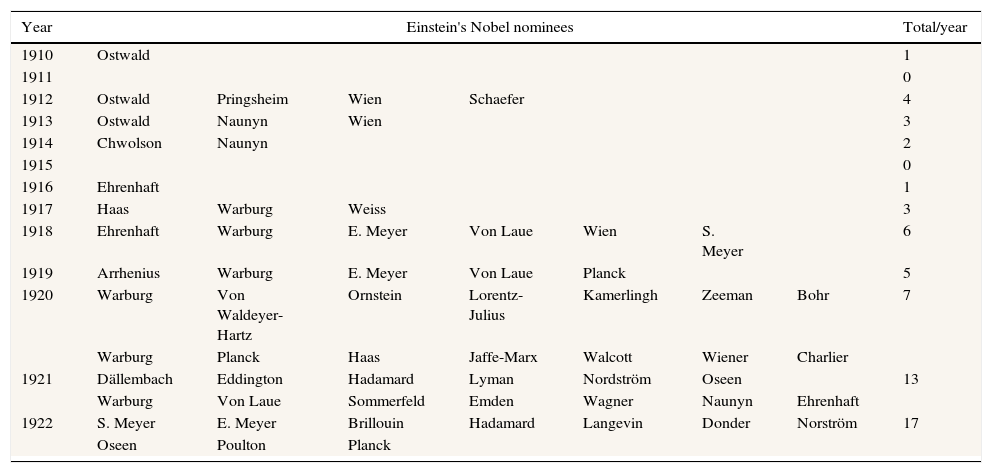Light's nature has fascinated the curiosity of many great scientists. One of them was Albert Einstein, who was able to predict its trajectories across the space-time continuum deformed by gravity. This deformity was established in Einstein's General Theory of Relativity, formulated in 1915.1 UNESCO chose this year, 2015, as the International Year of Light to celebrate Einstein's discoveries a century ago (http://www.light2015.org/Home.html). Although Einstein is most known for his Theory of Relativity, he was not honored with the Nobel Price for it, but rather for another important discovery also related to light: the explanation of the photoelectric effect.2
As of today, there has only been one Nobel Prize directly related to Optometry, the one received in Physiology or Medicine by Allvar Gullstrand in 1911 “for his work on the optical image”. (Curiously, Gullstrand also received the Nobel Prize in Physics that year, but he refused it, probably because he had joined the Nobel Committee of Physics a few months before the prize was awarded). Gullstrand was a Swedish doctor who became a full professor of Ophthalmology at the University of Uppsala (Sweden) in 1894. He conducted several studies on astigmatism and the accommodation of the human eye, and developed a number of apparatuses that are still used today in Optometry and Ophthalmology, such as the slit lamp.3 Curiously, Gullstrand did not have a specific background in physics or math, and he was mainly an autodidact in Optics.
Every year the Nobel Committee for Physics studies all the nominations of the year and proposes a name to the Section of Physics of the Academy of Sciences. If that Section agrees, the proposed name is voted on by the whole Swedish Academy of Science. That is the last step in winning the Nobel Prize in Physics. In the entire history of the Nobel Prize, there have been very few cases in which the name proposed by the Nobel Committee for Physics has not been finally awarded. From 1910 to 1921, Einstein was nominated 62 times (see table), most of them for the Theory of Relativity (Special4 or General1), but always without success.
| Year | Einstein's Nobel nominees | Total/year | ||||||
|---|---|---|---|---|---|---|---|---|
| 1910 | Ostwald | 1 | ||||||
| 1911 | 0 | |||||||
| 1912 | Ostwald | Pringsheim | Wien | Schaefer | 4 | |||
| 1913 | Ostwald | Naunyn | Wien | 3 | ||||
| 1914 | Chwolson | Naunyn | 2 | |||||
| 1915 | 0 | |||||||
| 1916 | Ehrenhaft | 1 | ||||||
| 1917 | Haas | Warburg | Weiss | 3 | ||||
| 1918 | Ehrenhaft | Warburg | E. Meyer | Von Laue | Wien | S. Meyer | 6 | |
| 1919 | Arrhenius | Warburg | E. Meyer | Von Laue | Planck | 5 | ||
| 1920 | Warburg | Von Waldeyer-Hartz | Ornstein | Lorentz-Julius | Kamerlingh | Zeeman | Bohr | 7 |
| Warburg | Planck | Haas | Jaffe-Marx | Walcott | Wiener | Charlier | ||
| 1921 | Dällembach | Eddington | Hadamard | Lyman | Nordström | Oseen | 13 | |
| Warburg | Von Laue | Sommerfeld | Emden | Wagner | Naunyn | Ehrenhaft | ||
| 1922 | S. Meyer | E. Meyer | Brillouin | Hadamard | Langevin | Donder | Norström | 17 |
| Oseen | Poulton | Planck | ||||||
Except in 1910, the nominations for Einstein's Theory of Relativity always encountered the opposition of one member of the Nobel Physics committee: Allvar Gullstrand. Some examples of the reasons given by the Nobel Committee of Physics for rejecting the nomination of Einstein's Nobel Prize for his work on Relativity were:5 “Their work is not enough usefull for humans”; “We should expect to have measurable evidence”; “…the Effects of Special Relativity that can be physically measured, are so small that fall within the limits of experimental error.”; “…It is just an extension of what has made Minkowski and Sommerfeld”, or “Theory of Relativity has a character of articles of faith rather than a scientific hypothesis”.
In 1921, when empirical evidences such as the procession of the perihelion of Mercury's orbit or the curved trajectory of the light from a start during an eclipse, had left no doubt about the certainty of the Theory of Relativity, Einstein's nomination for Relativity was once again rejected by the Nobel Physics Committee. However, by that time Einstein's Theory of Relatively was already well known within the scientific community and the legitimacy of the Nobel Prize Committee began to be questioned. In fact, this time the Section of Physics rejected the suggestion of the Nobel Committee, proposing instead Einstein's name to the general academy for the prize. Not surprisingly, Gullstrand was very upset by the decision and astonishingly, wrote two letters to the General Academy of Sciences in an effort to convince it that Einstein should not get the Nobel Prize for Relativity. Finally, the academy decided to delay the decision, and in December 1921, the Nobel Prize in Physics was postponed. The Swedish physicist Carl Wilhelm Oseen, who became part of the Nobel Physics Committee in 1922, realized the situation and nominated Einstein in 1921 and 1922 for his explanation of the Photoelectric Effect. Einstein thus finally was awarded in 1922 the Nobel Prize corresponding to 1921 “for his services to Theoretical Physics, and especially for his discovery of the law of the photoelectric effect”. Unfortunately, by that time (December 1922), Einstein had already been invited to Japan to explain his Theory of Relativity, and therefore could not attend the Nobel ceremony. He did, however, manage to go to Stockholm the following year (July 1923). Ironically, Einstein's acceptance speech for his Nobel Prize for the Photoelectric Effect was entitled “Fundamental Ideas and Problems of the Theory of Relativity”, which was, indeed, the topic most people were hoping to hear!









